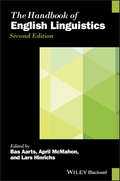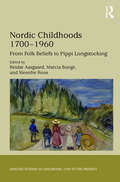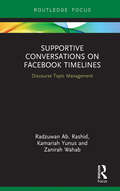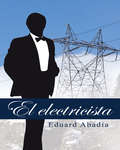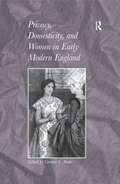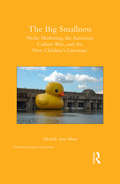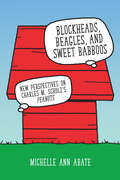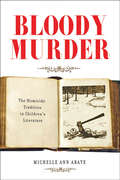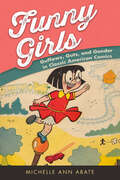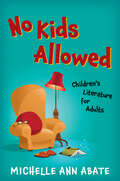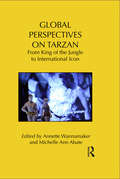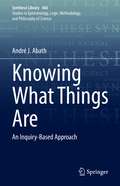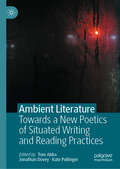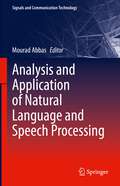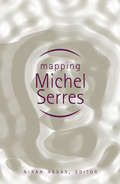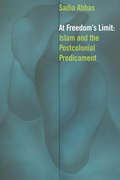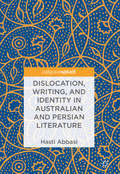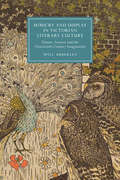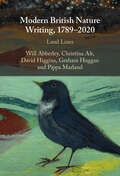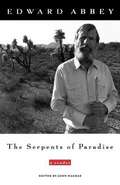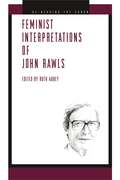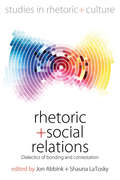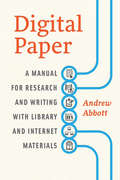- Table View
- List View
The Handbook of English Linguistics (Blackwell Handbooks in Linguistics #15)
by Bas Aarts April McMahon Lars HinrichsSecond edition of this popular Handbook bringing together stimulating discussions of core English linguistics topics in a single, authoritative volume—includes numerous new and thoroughly updated chapters The second edition of the popular Handbook of English Linguistics brings together stimulating discussions of the core topics in English linguistics in a single, authoritative volume. Written by an international team of experts, the chapters cover syntax, methodology, phonetics and phonology, lexis and morphology, variation, stylistics, and discourse, and also provide discussions of theoretical and descriptive research in the field. The revised edition includes new and updated chapters on English Corpus Linguistics, experimental approaches, complements and adjuncts, English phonology and morphology, lexicography, and more. In-depth yet accessible chapters introduce key areas of English linguistics, discuss relevant research, and suggest future research directions. An important academic contribution to the field, this book: Presents thirty-two in-depth, yet accessible, chapters that discuss new research findings across the field, written by both established and emerging scholars from around the world Builds upon the very successful first edition, published in 2006 Incorporates new trends in English linguistics, including digital research methods and theoretical advances in all subfields Suggests future research directions The Handbook of English Linguistics, 2nd Edition is an essential reference work for researchers and students working in the field of English language and linguistics.
Nordic Childhoods 1700–1960: From Folk Beliefs to Pippi Longstocking (Studies in Childhood, 1700 to the Present)
by Reidar Aasgaard Marcia Bunge Merethe RoosThis volume strengthens interest and research in the fields of both Childhood Studies and Nordic Studies by exploring conceptions of children and childhood in the Nordic countries (Denmark, Finland, Iceland, Norway, and Sweden). Although some books have been written about the history of childhood in these countries, few are multidisciplinary, focus on this region as a whole, or are available in English. This volume contains essays by scholars from the fields of literature, history, theology, religious studies, intellectual history, cultural studies, Scandinavian studies, education, music, and art history. Contributors study the history of childhood in a wide variety of sources, such as folk and fairy tales, legal codes, religious texts, essays on education, letters, sermons, speeches, hymns, paintings, novels, and school essays written by children themselves. They also examine texts intended specifically for children, including text books, catechisms, newspapers, songbooks, and children’s literature. By bringing together scholars from multiple disciplines who raise distinctive questions about childhood and take into account a wide range of sources, the book offers a fresh and substantive contribution to the history of childhood in the Nordic countries between 1700 and 1960. The volume also helps readers trace the historical roots of the internationally recognized practices and policies regarding child welfare within the Nordic countries today and prompts readers from any country to reflect on their own conceptions of and commitments to children.
Supportive Conversations on Facebook Timelines: Discourse Topic Management
by Radzuwan Ab. Rashid Kamariah Yunus Zanirah WahabThe emergence of social networking sites, like Facebook, and people’s engagement with one another through them is a relatively under-researched area for discourse analysis. The content of the book revolves around Discourse Topic Management which is under the theme of Discourse Analysis. It is written to extend the very limited literature in the area of Discourse Topic, especially for the discourse which takes place on social networking sites. This study discusses the characteristics of topical actions employed by English language teachers and their Facebook Friends in managing supportive conversations which take place on Timelines. In addition to employing new strategies, enabled by the particular features of the site, the teachers and their Friends also creatively adapt the strategies used in face-to-face conversations to manage their online conversations, thus contributing to the emergence of unique characteristics of discourse topic management in the context of social networking sites. The book brings together the existing frameworks of Discourse Topic Management, which are previously applied in the context of face-to-face conversations, and synthesizes the frameworks for a more comprehensive model into examining the conversations which take place on Facebook Timelines. The novelty of this book lies in its synthesized framework, the recontextualization of the framework for online conversations and the theoretical extension based on the data analysis presented in each chapter. Since people’s engagement with social networking sites is an emerging behaviour, this timely book provides insights into the phenomenon and also proposes a comprehensive analytical framework for other researchers interested in similar contexts.
El electricista
by Eduard AbadíaRicardo, un joven huérfano, llega a principios del siglo XX a Barcelona, una ciudad llena de oportunidades. <P><P>La ambición, la rebelión de los obreros y la primera guerra mundial serán el trasfondo de un acontecimiento muy importante tanto para él como para el progreso de la ciudad y de toda Catalunya: la construcción de la hidroeléctrica de La Vall Fosca, una de las obras más ambiciosas de aquella época, en la que él juega un papel clave. <P><P>Ricardo, a pesar de su juventud, se enfrentará a un escenario de luchas por el poder y se acabará convirtiendo en un hombre frio y calculador que sobrevivirá a la más despiadada ambición. <P><P>Pero Ricardo conserva en su interior el anhelo por encontrar la felicidad y lucha por encontrar el amor, debatiéndose entre dos mujeres que, junto con los acontecimientos ocurridos en el período entre 1900 y 1917, marcaran su vida para siempre. Una novela que te atrapará desde el principio haciendo que te identifiques con el personaje principal, Ricardo, y que sientas como propia su lucha por conseguir triunfar en el mundo de los negocios, pero manteniendo los principios morales que había aprendido en su infancia y su búsqueda del auténtico amor.
Privacy, Domesticity, and Women in Early Modern England
by Corinne S. AbateThe ten essays in this collection explore the discrete yet overlapping female spaces of privacy and domesticity in early modern England. While other literary critics have focused their studies of female privacy on widows, witches, female recusants and criminals, the contributors to this collection propose that the early modern subculture of femaleness is more expansive and formative than is typically understood. They maintain that the subculture includes segregated, sometimes secluded, domestic places for primarily female activities like nursing, sewing, cooking, and caring for children and the sick. It also includes hidden psychological realms of privacy, organized by women's personal habits, around intimate friendships or kinship, and behind institutional powerlessness. The texts discussed in the volume include plays not only by Shakespeare but also Ford, Wroth, Marvell, Spenser and Cavendish, among others. Through the lens of literature, contributors consider the unstructured, fluid quality of much everyday female experience as well as the dimensions, symbols, and the ever-changing politics and culture of the household. They analyze the complex habits of female settings-the verbal, spatial, and affective strategies of early-modern women's culture, including private rituals, domestic practices, and erotic attachments-in order to provide a broader picture of female culture and of female authority. The authors argue-through a range of critical approaches that include feminist, historical, and psychoanalytic-that early modern women often transformed their confinement into something useful and necessary, creating protected and even sacred spaces with their own symbols and aesthetic.
The Big Smallness: Niche Marketing, the American Culture Wars, and the New Children’s Literature (Children's Literature and Culture)
by Michelle Ann AbateThis book is the first full-length critical study to explore the rapidly growing cadre of amateur-authored, independently-published, and niche-market picture books that have been released during the opening decades of the twenty-first century. Emerging from a powerful combination of the ease and affordability of desktop publishing software; the promotional, marketing, and distribution possibilities allowed by the Internet; and the tremendous national divisiveness over contentious socio-political issues, these texts embody a shift in how narratives for young people are being creatively conceived, materially constructed, and socially consumed in the United States. Abate explores how titles such as My Parents Open Carry (about gun laws), It’s Just a Plant (about marijuana policy), and My Beautiful Mommy (about the plastic surgery industry) occupy important battle stations in ongoing partisan conflicts, while they are simultaneously changing the landscape of American children’s literature. The book demonstrates how texts like Little Zizi and Me Tarzan, You Jane mark the advent of not simply a new commercial strategy in texts for young readers; they embody a paradigm shift in the way that narratives are being conceived, constructed, and consumed. Niche market picture books can be seen as a telling barometer about public perceptions concerning children and the social construction of childhood, as well as the function of narratives for young readers in the twenty-first century. At the same time, these texts reveal compelling new insights about the complex interaction among American print culture, children’s reading practices, and consumer capitalism. Amateur-authored, self-published, and specialty-subject titles reveal the way in which children, childhood, and children’s literature are both highly political and heavily politicized in the United States. The book will be of interest to scholars and students in the fields of American Studies, children’s literature, childhood studies, popular culture, political science, microeconomics, psychology, advertising, book history, education, and gender studies.
Blockheads, Beagles, and Sweet Babboos: New Perspectives on Charles M. Schulz's Peanuts
by Michelle Ann AbateBlockheads, Beagles, and Sweet Babboos: New Perspectives on Charles M. Schulz's "Peanuts" sheds new light on the past importance, ongoing significance, and future relevance of a comics series that millions adore: Charles M. Schulz’s Peanuts. More specifically, it examines a fundamental feature of the series: its core cast of characters. In chapters devoted to Charlie Brown, Snoopy, Lucy, Franklin, Pigpen, Woodstock, and Linus, author Michelle Ann Abate explores the figures who made Schulz’s strip so successful, so influential, and—above all—so beloved. In so doing, the book gives these iconic figures the in-depth critical attention that they deserve and for which they are long overdue. Abate considers the exceedingly familiar characters from Peanuts in markedly unfamiliar ways. Drawing on a wide array of interpretive lenses, Blockheads, Beagles, and Sweet Babboos invites readers to revisit, reexamine, and rethink characters that have been household names for generations. Through this process, the chapters demonstrate not only how Schulz’s work remains a subject of acute critical interest more than twenty years after the final strip appeared, but also how it embodies a rich and fertile site of social, cultural, and political meaning.
Bloody Murder: The Homicide Tradition in Children's Literature
by Michelle Ann Abate"Off with her head!" decreed the Queen of Hearts, one of a multitude of murderous villains populating the pages of children's literature explored in this volume.Given the long-standing belief that children ought to be shielded from disturbing life events, it is surprising to see how many stories for kids involve killing. Bloody Murder is the first full-length critical study of this pervasive theme of murder in children’s literature. Through rereadings of well-known works, such as Alice’s Adventures in Wonderland, the Nancy Drew Mystery Stories, and The Outsiders, Michelle Ann Abate explores how acts of homicide connect these works with an array of previously unforeseen literary, social, political, and cultural issues. Topics range from changes in the America criminal justice system, the rise of forensic science, and shifting attitudes about crime and punishment to changing cultural conceptions about the nature of evil and the different ways that murder has been popularly presented and socially interpreted. Bloody Murder adds to the body of inquiry into America's ongoing fascination with violent crime. Abate argues that when narratives for children are considered along with other representations of homicide in the United States, they not only provide a more accurate portrait of the range, depth, and variety of crime literature, they also alter existing ideas about the meaning of violence, the emotional appeal of fear, and the cultural construction of death and dying.
Funny Girls: Guffaws, Guts, and Gender in Classic American Comics
by Michelle Ann AbateFor several generations, comics were regarded as a boys’ club—created by, for, and about men and boys. In the twenty-first century, however, comics have seen a rise of female creators, characters, and readers. While this sudden presence of women and girls in comics is being regarded as new and noteworthy, the observation is not true for the genre’s entire history. Throughout the first half of the twentieth century, the medium was enjoyed equally by both sexes, and girls were the protagonists of some of the earliest, most successful, and most influential comics. In Funny Girls: Guffaws, Guts, and Gender in Classic American Comics, Michelle Ann Abate examines the important but long-overlooked cadre of young female protagonists in US comics during the first half of the twentieth century. She treats characters ranging from Little Orphan Annie and Nancy to Little Lulu, Little Audrey of the Harvey Girls, and Li’l Tomboy—a group that collectively forms a tradition of Funny Girls in American comics. Abate demonstrates the massive popularity these Funny Girls enjoyed, revealing their unexplored narrative richness, aesthetic complexity, and critical possibility. Much of the humor in these comics arose from questioning gender roles, challenging social manners, and defying the status quo. Further, they embodied powerful points of collection about both the construction and intersection of race, class, gender, and age, as well as popular perceptions about children, representations of girlhood, and changing attitudes regarding youth. Finally, but just as importantly, these strips shed light on another major phenomenon within comics: branding, licensing, and merchandising. Collectively, these comics did far more than provide amusement—they were serious agents for cultural commentary and sociopolitical change.
No Kids Allowed: Children's Literature for Adults
by Michelle Ann AbateChildren's literature isn't just for children anymore. This original study explores the varied forms and roles of children's literature—when it's written for adults.What do Adam Mansbach's Go the F**k to Sleep and Barbara Park's MA! There's Nothing to Do Here! have in common? These large-format picture books are decidedly intended for parents rather than children. In No Kids Allowed, Michelle Ann Abate examines a constellation of books that form a paradoxical new genre: children's literature for adults. Distinguishing these books from YA and middle-grade fiction that appeals to adult readers, Abate argues that there is something unique about this phenomenon. Principally defined by its form and audience, children's literature, Abate demonstrates, engages with more than mere nostalgia when recast for grown-up readers. Abate examines how board books, coloring books, bedtime stories, and series detective fiction written and published specifically for adults question the boundaries of genre and challenge the assumption that adulthood and childhood are mutually exclusive.
Global Perspectives on Tarzan: From King of the Jungle to International Icon (Routledge Research in Cultural and Media Studies)
by Michelle Ann Abate Annette WannamakerThis collection seeks to understand the long-lasting and global appeal of Tarzan: Why is a story about a feral boy, who is raised by apes in the African jungle, so compelling and so adaptable to different cultural contexts and audiences? How is it that the same narrative serves as the basis for both children’s cartoons and lavish musical productions or as a vehicle for both nationalistic discourse and for light romantic fantasy? Considering a history of criticism that highlights the imperialistic, sexist, racist underpinnings of the original Tarzan narrative, why would this character and story appeal to so many readers and viewers around the world? The essays in this volume, written by scholars living and working in Australia, Canada, Israel, The Netherlands, Germany, France and the United States explore these questions using various critical lenses. Chapters include discussions of Tarzan novels, comics, television shows, toys, films, and performances produced or distributed in the U.S., Canada, Israel, Palestine, Britain, India, The Netherlands, Germany and France and consider such topics as imperialism, national identities, language acquisition, adaptation, gender constructions, Tarzan’s influence on child readers and Tarzan’s continued and broad influence on cultures around the world. What emerges, when these pieces are placed into dialogue with one another, is an immensely complex picture of an enduring, multi-faceted global pop culture icon.
Knowing What Things Are: An Inquiry-Based Approach (Synthese Library #466)
by André J. AbathThis book provides an account of what is to know what things are, focusing on kinds, both natural (such as water) and social (such as marriage). It brings tools from an area that has received much attention in recent years, the epistemology of inquiry. The knowledge of what things are is to be understood as resulting from successful inquiries directed at questions of the form ‘What is x?’, where x stands for a given kind of thing. The book also addresses knowledge-wh in general (which includes knowledge-who and knowledge-where), as well as the phenomenon of ignorance regarding what things are and our obligations in respect to knowing what things are. It also brings to light new avenues of research for those interested in the relation between the knowledge of what things are and concept possession and amelioration.‘Knowing What Things Are’ should be of interest to researchers in Epistemology, Philosophy of Language, Metaphysics, Philosophy of Mind, Social Philosophy and Linguistics.
Ambient Literature: Towards a New Poetics of Situated Writing and Reading Practices
by Tom Abba Jonathan Dovey Kate PullingerThis book considers how a combination of place-based writing and location responsive technologies produce new kinds of literary experiences. Building on the work done in the Ambient Literature Project (2016–2018), this books argues that these encounters constitute new literary forms, in which the authored text lies at the heart of an embodied and mediated experience. The visual, sonic, social and historic resources of place become the elements of a live and emergent mise-en-scène. Specific techniques of narration, including hallucination, memory, history, place based writing, and drama, as well as reworking of traditional storytelling forms combine with the work of app and user experience design, interaction, software authoring, and GIS (geographical information systems) to produce ambient experiences where the user reads a textual and sonic literary space. These experiences are temporary, ambiguous, and unpredictable in their meaning but unlike the theatre, the gallery, or the cinema they take place in the everyday shared world. The book explores the potentiality of a new literary form produced by the exchange between location-aware cultural objects, writers and readers. This book, and the work it explores, lays the ground for a new poetics of situated writing and reading practices.
Analysis and Application of Natural Language and Speech Processing (Signals and Communication Technology)
by Mourad AbbasThis book presents recent advances in NLP and speech technology, a topic attracting increasing interest in a variety of fields through its myriad applications, such as the demand for speech guided touchless technology during the Covid-19 pandemic. The authors present results of recent experimental research that provides contributions and solutions to different issues related to speech technology and speech in industry. Technologies include natural language processing, automatic speech recognition (for under-resourced dialects) and speech synthesis that are useful for applications such as intelligent virtual assistants, among others. Applications cover areas such as sentiment analysis and opinion mining, Arabic named entity recognition, and language modelling. This book is relevant for anyone interested in the latest in language and speech technology.
Mapping Michel Serres
by Niran AbbasThe work of Michel Serres---including the books Hermes, The Parasite, The Natural Contract, Genesis, The Troubadour of Knowledge, and Conversations on Science, Culture, and Time---has stimulated readers for years, as it challenges the boundaries of science, literature, culture, language, and epistemology. The essays in Mapping Michel Serres, written by the leading interpreters of his work, offer perspectives from a range of disciplinary positions, including literature, language studies, and cultural theory. Contributors include Maria Assad, Hanjo Berressem, Stephen Clucas, Steven Connor, Andrew Gibson, René Girard, Paul Harris, Marcel Hénaff, William Johnsen, William Paulson, Marjorie Perloff, Philipp Schweighauser, Isabella Winkler, and Julian Yates.
At Freedom's Limit: Islam and the Postcolonial Predicament
by Sadia AbbasThe subject of this book is a new “Islam.” This Islam began to take shape in 1988 around the Rushdie affair, the collapse of the Berlin Wall in 1989, and the first Gulf War of 1991. It was consolidated in the period following September 11, 2001. It is a name, a discursive site, a signifier at once flexible and constrained—indeed, it is a geopolitical agon, in and around which some of the most pressing aporias of modernity, enlightenment, liberalism, and reformation are worked out. At this discursive site are many metonyms for Islam: the veiled or “pious” Muslim woman, the militant, the minority Muslim injured by Western free speech. Each of these figures functions as a cipher enabling repeated encounters with the question “How do we free ourselves from freedom?” Again and again, freedom is imagined as Western, modern, imperial—a dark imposition of Enlightenment. The pious and injured Muslim who desires his or her own enslavement is imagined as freedom’s other. At Freedom’s Limit is an intervention into current debates regarding religion, secularism, and Islam and provides a deep critique of the anthropology and sociology of Islam that have consolidated this formation. It shows that, even as this Islam gains increasing traction in cultural production from television shows to movies to novels, the most intricate contestations of Islam so construed are to be found in the work of Muslim writers and painters. This book includes extended readings of jihadist proclamations; postcolonial law; responses to law from minorities in Muslim-majority societies; Islamophobic films; the novels of Leila Aboulela, Mohammed Hanif, and Nadeem Aslam; and the paintings of Komail Aijazuddin.
Dislocation, Writing, and Identity in Australian and Persian Literature
by Hasti AbbasiThis study aims to foreground key literary works in Persian and Australian culture that deal with the representation of exile and dislocation. Through cultural and literary analysis, Dislocation, Writing, and Identity in Australian and Persian Literature investigates the influence of dislocation on self-perception and the remaking of connections both through the act of writing and the attempt to transcend social conventions. Examining writing and identity in David Malouf’s An Imaginary Life (1978), Iranian Diaspora Literature, and Shahrnush Parsipur’s Women Without Men (1989/ Eng.1998), Hasti Abbasi provides a literary analysis of dislocation, with its social and psychological manifestations. Abbasi reveals how the exploration of exile/dislocation, as a narrative that needs to be investigated through imagination and meditation, provides a mechanism for creative writing practice.
Cambridge Studies in Nineteenth-Century Literature and Culture: English Fiction and the Evolution of Language, 1850–1914
by Will AbberleyVictorian science changed language from a tool into a natural phenomenon, evolving independently of its speakers. Will Abberley explores how science and fiction interacted in imagining different stories of language evolution. Popular narratives of language progress clashed with others of decay and degeneration. Furthermore, the blurring of language evolution with biological evolution encouraged Victorians to re-imagine language as a mixture of social convention and primordial instinct. Abberley argues that fiction by authors such as Charles Kingsley, Thomas Hardy and H. G. Wells not only reflected these intellectual currents, but also helped to shape them. Genres from utopia to historical romance supplied narrative models for generating thought experiments in the possible pasts and futures of language. Equally, fiction that explored the instinctive roots of language intervened in debates about language standardisation and scientific objectivity. These textual readings offer new perspectives on twenty-first-century discussions about language evolution and the language of science.
Mimicry and Display in Victorian Literary Culture: Nature, Science and the Nineteenth-Century Imagination (Cambridge Studies in Nineteenth-Century Literature and Culture #123)
by Will AbberleyRevealing the web of mutual influences between nineteenth-century scientific and cultural discourses of appearance, Mimicry and Display in Victorian Literary Culture argues that Victorian science and culture biologized appearance, reimagining imitation, concealment and self-presentation as evolutionary adaptations. Exploring how studies of animal crypsis and visibility drew on artistic theory and techniques to reconceptualise nature as a realm of signs and interpretation, Abberley shows that in turn, this science complicated religious views of nature as a text of divine meanings, inspiring literary authors to rethink human appearances and perceptions through a Darwinian lens. Providing fresh insights into writers from Alfred Russel Wallace and Thomas Hardy to Oscar Wilde and Charlotte Perkins Gilman, Abberley reveals how the biology of appearance generated new understandings of deception, identity and creativity; reacted upon narrative forms such as crime fiction and the pastoral; and infused the rhetoric of cultural criticism and political activism.
Modern British Nature Writing, 1789–2020: Land Lines
by Will Abberley Christina Alt David Higgins Graham Huggan Pippa MarlandWhy do we speak so much of nature today when there is so little of it left? Prompted by this question, this study offers the first full-length exploration of modern British nature writing, from the late eighteenth century to the present. Focusing on non-fictional prose writing, the book supplies new readings of classic texts by Romantic, Victorian and Contemporary authors, situating these within the context of an enduringly popular genre. Nature writing is still widely considered fundamentally celebratory or escapist, yet it is also very much in tune with the conflicts of a natural world under threat. The book's four authors connect these conflicts to the triple historical crisis of the environment; of representation; and of modern dissociated sensibility. This book offers an informed critical approach to modern British nature writing for specialist readers, as well as a valuable guide for general readers concerned by an increasingly diminished natural world.
The Serpents of Paradise
by Edward AbbeyThe selections gathered here are arranged chronologically by incident, not by date of publication, to offer Edward Abbey's life from the time he was the boy called Ned in Home, Pennsylvania, until his death in Tucson at age 62.
Feminist Interpretations of John Rawls: Feminist Interpretations Of John Rawls (Re-Reading the Canon)
by Ruth AbbeyIn Feminist Interpretations of John Rawls, Ruth Abbey collects eight essays responding to the work of John Rawls from a feminist perspective. An impressive introduction by the editor provides a chronological overview of English-language feminist engagements with Rawls from his Theory of Justice onward. Abbey surveys the range of issues canvassed by feminist readers of Rawls, as well as critics’ wide disagreement about the value of Rawls’s corpus for feminist purposes. The eight essays that follow testify to the continuing ambivalence among feminist readers of Rawls. From the perspectives of political theory and moral, social, and political philosophy, the contributors address particular aspects of Rawls’s work and apply it to a variety of worldly practices relating to gender inequality and the family, to the construction of disability, to justice in everyday relationships, and to human rights on an international level. The overall effect is to give a sense of the broad spectrum of possible feminist critical responses to Rawls, ranging from rejection to adoption.Aside from the editor, the contributors are Amy R. Baehr, Eileen Hunt Botting, Elizabeth Brake, Clare Chambers, Nancy J. Hirschmann, Anthony Simon Laden, Janice Richardson, and Lisa H. Schwartzman.
Feminist Interpretations of John Rawls (Re-Reading the Canon)
by Ruth AbbeyIn Feminist Interpretations of John Rawls, Ruth Abbey collects eight essays responding to the work of John Rawls from a feminist perspective. An impressive introduction by the editor provides a chronological overview of English-language feminist engagements with Rawls from his Theory of Justice onward. Abbey surveys the range of issues canvassed by feminist readers of Rawls, as well as critics’ wide disagreement about the value of Rawls’s corpus for feminist purposes. The eight essays that follow testify to the continuing ambivalence among feminist readers of Rawls. From the perspectives of political theory and moral, social, and political philosophy, the contributors address particular aspects of Rawls’s work and apply it to a variety of worldly practices relating to gender inequality and the family, to the construction of disability, to justice in everyday relationships, and to human rights on an international level. The overall effect is to give a sense of the broad spectrum of possible feminist critical responses to Rawls, ranging from rejection to adoption.Aside from the editor, the contributors are Amy R. Baehr, Eileen Hunt Botting, Elizabeth Brake, Clare Chambers, Nancy J. Hirschmann, Anthony Simon Laden, Janice Richardson, and Lisa H. Schwartzman.
Rhetoric and Social Relations: Dialectics of Bonding and Contestation (Studies in Rhetoric and Culture #8)
by Jon Abbink Shauna LaToskyThis volume explores the constitutive role of rhetoric in socio-cultural relations, where discursive persuasion is so important, and contains both theoretical chapters as well as fascinating examples of the ambiguities and effects of rhetoric used (un)consciously in social praxis. The elements of power, competition and political persuasion figure prominently. It is an accessible collection of studies, speaking to common issues and problems in social life, and shows the heuristic and often explanatory value of the rhetorical perspective.
Digital Paper: A Manual for Research and Writing with Library and Internet Materials
by Andrew AbbottToday’s researchers have access to more information than ever before. Yet the new material is both overwhelming in quantity and variable in quality. How can scholars survive these twin problems and produce groundbreaking research using the physical and electronic resources available in the modern university research library? In Digital Paper, Andrew Abbott provides some much-needed answers to that question. Abbott tells what every senior researcher knows: that research is not a mechanical, linear process, but a thoughtful and adventurous journey through a nonlinear world He breaks library research down into seven basic and simultaneous tasks: design, search, scanning/browsing, reading, analyzing, filing, and writing. He moves the reader through the phases of research, from confusion to organization, from vague idea to polished result. He teaches how to evaluate data and prior research; how to follow a trail to elusive treasures; how to organize a project; when to start over; when to ask for help. He shows how an understanding of scholarly values, a commitment to hard work, and the flexibility to change direction combine to enable the researcher to turn a daunting mass of found material into an effective paper or thesis. More than a mere how-to manual, Abbott’s guidebook helps teach good habits for acquiring knowledge, the foundation of knowledge worth knowing. Those looking for ten easy steps to a perfect paper may want to look elsewhere. But serious scholars, who want their work to stand the test of time, will appreciate Abbott’s unique, forthright approach and relish every page of Digital Paper.
